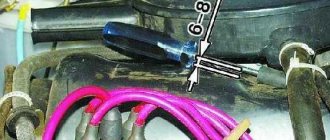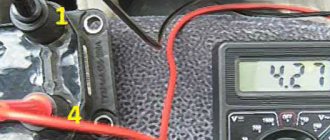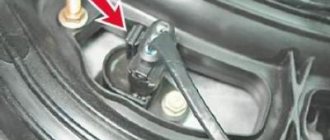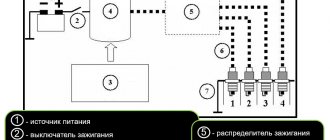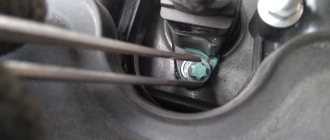- problem with spark plugs (flooded or faulty);
- breakdown of high-voltage wires or loss of contact;
- the reason is the crankshaft sensor (requires checking with a multimeter);
- malfunction in the ignition module;
- failure of the ignition coil;
- problem in the switch;
- Distributor malfunction (burned contacts, loss of clearance);
- poor ground wire contact;
- failure or malfunction of the ECU.
It is recommended to use a spark gap to understand at what stage there is no spark on the spark plugs (no spark from the distributor, no spark from the coil, or directly from the spark plug itself). If there is no spark in all cylinders at the same time, there may be several culprits:
- controller;
- entire module;
- coil or center wire.
If there is no spark from the ignition coil, then the reason may be hidden in many places. First of all, you need to check the high-voltage armored wire, which must be in perfect condition and without breaking the insulation. Otherwise, the wire needs to be replaced.
No spark, check spark plugs
If the problem is not solved, then check the spark plugs. The spark plug contacts must be clean. The fact that there is no spark may be caused by dirty spark plug contacts. It is best to replace the spark plugs, but you can also clean the contacts. But before changing the spark plugs, check whether the discharge reaches the spark plugs themselves. To do this, remove the spark plug wire and bring it to the car body at a distance of 0.5 cm. Turn the starter several times and see if there is a spark between the wire and the body. The spark should be white with a slight blue tint. If it is absent or present, but with a different shade, we can say that the spark plugs are fine, and the problem is in the heart of the car’s ignition system - the coil.
How to check
To confirm that the engine is not starting because it has no spark, you can do any of the following.
WARNING: The secondary ignition voltage may cause serious consequences if it comes into contact with the human body. Do not hold or touch the spark plug wire while cranking the engine.
If your engine has spark plug wires, disconnect one of the plug cables from the spark plug and place the end of the wire near a metal surface of the engine. Then try to start the engine. A spark should appear between the wire and the metal plate. If a spark is not detected, then there are obvious problems with the ignition.
This is what a perfect spark looks like
Of course, the structure of a car is not simple, but a schematic understanding of its structure allows us to approximately detect the source of the malfunction. If there is no spark, then the problem is in the “Battery - generator - spark plug” section.
Remove the gasket and insert the old spark plug or spark plug tester into the end of the high voltage spark plug wire. Place the spark plug on a metal surface of the engine or ground the spark plug tester to the engine. Then start the engine to check for spark.
Finding a lack of spark on an injection engine:
If your engine has an ignition system with an ignition coil without plug wires, remove one of the coils from the spark plug and insert the old plug into the end of the coil. Point the spark plug at the engine, then start the engine. There is a spark - there was a problem with the spark plug, there is no spark - the spark plug can be excluded from the list of possible defects.
Spray aerosol starting fluid into the throttle body (remember that starting fluid is extremely flammable!). Then start the engine. If the engine starts, you do not have an ignition problem, the starting problem was fuel related.
Ignition circuit
Glazing
The surface of the spark plug insulator is glossy, yellowish in color. Those who like to press hard on the gas have the greatest chance of seeing such a spark plug on the engine of their own car. The formation of glaze on the insulator occurs due to a rapid increase in temperature in the combustion chamber at the moment of sharp pressing of the gas pedal. When heated, ordinary deposits on the surface of the insulator melt, forming an electrically conductive glassy coating. As a result, sparking failures occur, especially at high engine speeds. The spark plug cannot be restored; it must be replaced.
Lost spark - reasons
When checking, attention is paid not only to components and assemblies, but also to the condition of the electrical wiring connections and the cleanliness of the terminals. What to check:
- terminals;
- battery;
- High voltage wires;
- distributor;
- low voltage system;
- candles.
Battery diagnostics
Low battery charge, contact breakdown is the reason that a spark does not form. A sign that the battery is running low is an uncharacteristically quiet car beep and lights going off on the dashboard when you start the engine. What to check:
- Battery terminals. If traces of oxidation are visible, clean and tighten the terminals. Graphite lubricant helps prevent oxide formation.
- Capacity. Let's recharge.
Diagnostics of high-voltage wires
High voltage wire breakdown is another common reason why the spark disappears. It is advisable for the driver to inspect the wires, starting with the cables that go to the spark plugs. We remove the tip from the spark plug, inspect the wire for breaks, abrasions, integrity of the insulation, and check the condition of the tips. We check the functionality of the cable itself with a multimeter.
There is one more way to check the quality of the current that passes through the CV wire, but you will need the help of a partner. We remove the wire from the spark plug, bring it to the body without touching the metal, then turn the starter for 2-3 seconds. The working wires produce a stable spark of a white glow with a blue tint at the tip.
Coil
If the wires, contacts, battery capacity and spark plugs have been checked, but there is no spark, the coils are next on the check list. We remove the main wire from the cover and bring it to ground, while simultaneously turning the starter. A faulty coil prevents a spark from forming, and if a bright, stable spark is observed, the distributor is faulty.
During diagnostics, we carefully look at all the terminals - acidified contacts lead to a weak spark or its absence.
Low Voltage Circuit Test
Causes of malfunction that lead to a lack of spark on the spark plug:
- oxidation of breaker contacts;
- break in the wire connecting the breaker terminal to the lever;
- Broken wire of the movable disk.
If the terminals are clogged with oxide, clean the contacts, adjust the gap and check the current supply. If the contacts are broken, we restore the wiring.
We check the functionality of the circuit using a 12-volt light bulb. We connect the light bulb on one side to the ground of the car, on the other - to the low voltage terminal, and close the contact. If the circuit is working normally, the lamp goes out when the circuit is closed and lights up when the connector is disconnected.
If the control light does not light up when the contacts are disconnected, in addition to broken wires and a soured terminal, the reason for the lack of a spark may be a burnt-out ignition coil.
If there is no spark on cars with an injection engine, we use a spark gap for diagnostics. We check the coil, main wire, controller, as well as the electronic unit module, fuses and high voltage wires.
What to do?
Based on the advice of experienced car enthusiasts, we suggest checking the possible causes of the malfunction. First of all, use a spark gap to know where exactly the spark disappears. If the cylinders are faulty, pay attention to the controller, the module as a whole, or the coil.
Start with a visual inspection of the high-voltage wire (the ideal is good external condition with intact insulation). Repair or replace the element as necessary.
If the problem is not found, we go directly to the SZ. Clean or replace rusty contacts if necessary. Before making a decision, test the presence of a discharge on the spark plugs: bring the wire 0.5 cm to the metal and spin the starter. A blue-white spark signals normality. Another color (purple, for example) - go to the coil (KZ).
The operation of the coil is tested in the same way as the discharge on spark plugs (see above). Two scenarios:
sparked - see distributor-breaker (R/P);
did not “ignite” (deal with the coil).
In the R/P it is necessary to exclude oxidation, insulation failure and test the rotor. Inspect the inside of the cover to ensure there are no cracks. Check the carbon contact with your hand to see if it is stuck. Insulation check:
place the central high-voltage wire 0.8 cm from the electrode;
connect and disconnect the contact (turn on the ignition first).
If the rotor is faulty, sparks are visible.
In a short circuit, exclude damage to the winding and short circuit (burnt points).
The low voltage circuit is tested with a twelve-volt light bulb with a power of no more than 3 W. It is connected to the breaker and the hardware of the car. Next, close the R/P and turn on the ignition. If the circuit is working properly, the standard lights up when it opens and goes out when it closes. “Controller” does not go out under the following circumstances:
No spark on VAZ 2106
Sparking is an important process that ensures the startup and stable operation of the power unit, for which the ignition system is responsible. The latter can be contact or non-contact, but the essence of its work remains the same - to ensure the formation and distribution of a spark to the desired cylinder at a certain point in time. If this does not happen, the engine may either not start at all or run intermittently. Therefore, it is worth dwelling in more detail on what kind of spark there should be and what the reasons for its absence may be.
Why do you need a spark?
Since the VAZ 2106 and other “classics” are equipped with an internal combustion engine, the operation of which is ensured by the combustion of the fuel-air mixture, a spark is required to ignite the latter. To obtain it, the car is equipped with an ignition system, in which the main elements are spark plugs, high-voltage (HV) wires, a distributor-breaker and an ignition coil. Both spark formation as a whole and the quality of the spark depend on the performance of each of them. The principle of obtaining a spark is quite simple and comes down to the following steps:
- Contacts located in the distributor provide low voltage supply to the primary winding of the high-voltage coil.
- When the contacts open, a high voltage is indicated at the coil output.
- High-voltage voltage is supplied through the central wire to the ignition distributor, through which sparks are distributed to the cylinders.
- A spark plug is installed in the cylinder head for each cylinder, to which voltage is supplied via explosive wires, as a result of which a spark is formed.
- When a spark appears, the combustible mixture ignites, ensuring the operation of the engine.
Troubleshooting algorithm
In all other cases, the search for ignition problems begins from the end and in order. After each step, check the spark.
- Replace the old spark plug with a guaranteed working one.
- If the model has a removable spark plug cap, remove it, and the exposed spark plug wire is connected to ground with a gap similar to that of a spark plug. They pull the starter. If a spark
, the problem is in the cap. She is being eliminated. - Change the spark plug wire where it is possible to remove it from the source.
- Visually inspect the wires from the switch. Vibration or contact with metal can cause damage. If there are friction points, the wire is replaced, even if there is no external damage to the insulation. You can use a tester or multimeter to check the wire.
This is where minor and easily fixable problems end. If the problem is not solved, then the reason
more serious.
Modern coils and ignition systems on most chainsaws are very reliable. They are designed to last even longer than the entire chainsaw
as a whole. There are no mechanical moving parts like older cam systems. They are sufficiently insulated from clogging and moisture.
If, due to an accidental manufacturing defect, an interturn short circuit occurs in the coil or the electronics fail, these parts cannot be repaired. Will need to be replaced with new ones.
It is not uncommon for a mechanical failure to occur. Due to wear or destruction of the crankshaft bearing, play appears on it. And then the magnetic rotor begins to touch the body of the ignition system, inside which it rotates. This is a serious breakdown. You will need to “halve” (disassemble) the entire engine, replace the bearing, and put everything back in place.
Adjusting idle speed
Now, by turning the idle speed screw (T, LA, S) counterclockwise, adjust the minimum number of revolutions at which the engine is stable. The chain should not move. If the engine stops idling, turn the idle speed screw clockwise accordingly. If the chain moves, turn the screw counterclockwise.
READ Which Chainsaw to Choose for Your Home
Weak spark at the spark plugs. Why does the engine start poorly and not pull?
To finalize the chainsaw carburetor adjustment, we check the engine for acceleration and maximum speed.
Checking the spark on the spark plug and eliminating the causes.
The first step in finding the reasons why a gasoline saw does not start is to check the spark on the spark plug. There are many factors that influence the operation of this element. However, the main ones at the initial stage of tool troubleshooting are:
- Incorrect carburetor adjustment;
- The presence of more than the required amount of oil in gasoline;
- Air filter clogged.
All of them contribute to the formation of carbon deposits on the spark plug electrodes. In 50 cases out of 100, saws do not start when cold due to the lack of a spark due to carbon deposits on the electrodes and their corrosion. The result is either a decrease in the gap or an increase in it.
Checking the spark plug of a non-working chainsaw
Chainsaw searching for spark
Checking for spark is quite simple. To do this you will need:
- Remove the tip of the high-voltage wire;
- Unscrew the spark plug;
- Put the tip back on;
- Place the candle skirt against the cylinder;
- Start with the starter.
If, when starting the chainsaw engine, a good spark
, then everything is in order with the ignition unit. If it is not there, then it is worth cleaning the element itself and checking the electrode gap. If necessary, use a special probe to adjust the distance between the contacts.
There may be no spark at the spark plug for other reasons. The main malfunctions that affect poor starting of the chainsaw and unstable operation of the internal combustion engine at idle, which can cause the tool to stall, include the following:
- Overfilling of the spark plug channel with fuel;
- Lack of contact between the high-voltage cradle and the tip of the spark plug;
- Failure of the ignition unit.
How to start a cold chainsaw if the spark plug channel is constantly flooded with gasoline? You can fix the problem while starting the tool using the following algorithm:
- Unscrew the spark plug with a special wrench;
- Wipe it with a clean and dry cloth;
- Dry for 20...30 minutes;
- Remove carbon deposits with a file and adjust the gap between the electrodes;
- Drain the remaining fuel from the spark plug channel and dry it;
- Collect everything and try to start the mechanism.
If there is no spark due to poor contact of the high-voltage cradle with the tip of the spark plug, it is necessary to check the connection. The test can be carried out using a regular tester. If a defect is detected and eliminated, a chainsaw
It should start without any problems.
If the check shows that the contact is reliable, but the saw still does not start, look for the reason in the ignition unit. As a rule, a faulty unit cannot be repaired or restored. This will require a complete replacement.
Checking the acceleration
Smoothly press the accelerator and watch how quickly the engine picks up speed from idle to maximum power. If the engine revs slowly, it may be necessary to loosen the L (low speed) screw by turning it slightly counterclockwise (no more than 1/8 turn).
Checking the ignition distributor
If you suspect a malfunction of the breaker-distributor, you must carefully inspect its cover from the inside.
The lawn mower/chainsaw/motor mower is bad/does not start. WEAK SPARK. Replacing the ignition coil.
- If the cap is in order, then simply wash it with gasoline,
- If any cracks are found, the cover will need to be replaced.
The center carbon contact of the breaker is checked for sticking by lightly moving it with your finger.
The rotor insulation of the breaker-distributor is checked for breakdown as follows:
- Place the central high-voltage wire with a gap of 5-8 mm from the rotor electrode,
- After this, close and open the breaker contacts with your hand (the ignition must be turned on).
The appearance of sparks in the gap indicates a rotor malfunction that will need to be replaced.
Checking the battery
A clear sign of problems with the battery is a dull and quiet horn signal. Also, if there are problems with the battery, the indicator lights on the instrument panel usually go out while the starter is rotating. In this case, the reason for the lack of a spark may be poor contact at the terminals or a low battery charge.
- If the terminals are oxidized, they must be cleaned and tightened tightly. In addition, you can use graphite lubricant, which will reliably protect the contacts from oxidation in the future.
- If the battery is discharged, it must be charged using a charger.
For information on how to properly charge a car battery and maintain it, read our battery charging instructions.
Checking high voltage wires
Next, it’s worth inspecting the high-voltage wires: they must have a neat, not “tattered” appearance, without insulation damage, otherwise they will have to be replaced. If the wires are ok, then you can start looking for a spark.
We recommend starting your search for a spark with the spark plug wires. To do this, you need to remove the tip of the spark plug wire from the spark plug and bring it to the “ground” (the nearest unpainted metal part of the body or engine) at a distance of 5-8 mm, after which you need to turn on the starter for a few seconds.
READ Do-It-Yourself Chainsaw Carburetor Adjustment Caliber
The rotation of the starter should be accompanied by an uninterrupted bright spark of white color with a slight blue tint. If there is no spark, you need to check the ignition coil. A violet, red or yellow spark indicates a malfunction in the ignition system.
It is also worth noting that the spark plugs themselves rarely fail all at the same time. If there is a “spark” in the spark plug wires, you can check any spark plug by unscrewing it from the cylinder head and putting the spark plug wire on it. Touch the metal part of the spark plug to the “ground” of the car, and by rotating the starter, make sure that there is a spark at the spark plug electrodes.
It is necessary to change spark plugs within the time limits established by the maintenance regulations for your car (usually every 15-25 thousand km).
You can learn more about the markings and heat ratings of spark plugs from our material at this link.
Bringing the car back to life
As for why a spark disappears, everything is probably very clear. Now, it would not be amiss to consider the order of her return. The reality is that in most cases, getting the spark back is a simple matter and just involves carefully checking the broken car. To be more precise, to normalize sparking it is required:
- Firstly, check the spark on the injector using the method described above, make sure that it has disappeared, and, at least indirectly, try to determine the cause of the malfunction;
- Next, it is enough to assess the current circumstances and act based on them. As typical situations, we suggest considering solutions to the following problems:
- the spark plug is wet, the presence and strength of the spark are unimportant, the carbon deposits are correct (brick color) - wipe the part and screw it back in;
- the spark plug is wet (not always) and the carbon deposits are incorrect (white or black) - clean, dry the part and try to start the engine, if there is no result, change the spark plug and deal with problems in the fuel system (cleaning the injector, checking the ECU, etc.);
- the spark plug is wet, there is no spark at all, the color of the soot is not important - we try to change the part, if there is no result, we check the ignition system and the operation of the injector.
In principle, in theory there are no particular difficulties in repairs of this kind. Despite this, it often causes difficulties in implementation for inexperienced motorists. To solve these, you need to act in the order described above, but if something doesn’t work out, it’s better to turn to professionals at a service station. This approach to repairs will not only save time, but also guarantee trouble-free operation of the car in the future.
Perhaps this concludes the most important information on today’s issue. We hope that the material presented was useful to you and provided answers to your questions. Good luck in operating and maintaining your car!
If you have any questions, leave them in the comments below the article. We or our visitors will be happy to answer them
No spark at the spark plugs
Lack of spark on the spark plugs is one of two basic faults most often found on cars (the second is no fuel supply to the engine).
Loss of spark or weak spark from the spark plugs indicates problems in the ignition system. Either in a high voltage circuit or a low voltage circuit.
In this case, the car engine will not start at all (both cold and hot), or will start and stall (if there is a spark, but weak). Let's consider the main reasons for the loss of spark on carburetor engines of VAZ 2105, 2107, 2108, 2109, 21099 cars with contact and non-contact ignition systems.
Before troubleshooting, it is necessary to more specifically determine the culprit for the loss of spark and conduct a visual inspection of the high-voltage wires, ignition coil and distributor. A trivial central armor wire that has slipped off the distributor cover, a loose connector, or an oxidized (fallen off) terminal on the ignition coil will lead to the disappearance of the spark.
Then we remove the central high-voltage wire, insert a working spark plug into its tip and place it on the engine (so that there is contact with ground). While the assistant turns the engine with the starter, you need to visually verify the absence or presence of a spark at the spark plug. A spark has appeared - the spark plugs themselves, the high-voltage wires or the ignition distributor in the distributor are faulty. There was still no spark - problems with the switch, Hall sensor, ignition coil.
Lost spark, reasons for contactless ignition system
— Ignition coil failed
Checking the ignition coil. The ignition coil is usually checked for winding resistance and insulation resistance using a tester. For oil-filled coils (27.3705) and dry coils (3122.3707), the resistance is slightly different. Read more: “Checking the ignition coil.” In the absence of a special device for testing, we use the method of replacing our coil with another one that is known to be good.
Checking the primary winding of the ignition coil
— The switch is faulty
Checked with an oscilloscope. Since not everyone has it, we use the replacement method - instead of our switch we install a known good one. You can very roughly estimate the performance of the switch based on the voltmeter readings after turning on the ignition (see “Checking the switch”).
— Hall sensor is faulty
It is checked with a voltmeter according to a special connection diagram (see “Checking the Hall sensor”). If there is no voltmeter, we use the replacement method.
Hall sensor, check
— Open circuit in low voltage circuit
Using the diagram, we look through the wires included in the ignition system, and if necessary, “ring” to detect a “break.” See "Contactless Ignition System Diagram".
In the contact ignition system, the list of malfunctions leading to the disappearance of the spark is as follows:
— The mechanical breaker in the distributor is faulty
Its contacts have oxidized, collapsed or burned. There is no gap between the breaker contacts.
The quality of the spark on the spark plugs is checked in the same way as in its absence. However, it is advisable to change the gap with the high-voltage spark plug wire and ground. A spark is considered good if it penetrates a gap of at least 7 mm.
A weak spark on the spark plugs is a malfunction that occurs just as when there is none at all, but it is much more difficult to detect the cause of its occurrence. An ammeter won't even be able to help in this case. The best way to determine a malfunction is to turn off a particular device or section of the circuit from the ignition system and try, if possible, to get a spark without them. The appearance of a good spark indicates a malfunction of the switched off device.
When, after checking, it turns out that the spark between the spark plug and the high-voltage wire is weak, turn off the distributor from the ignition circuit and check the quality of the spark between the ground and the high-voltage wire of the ignition coil. The presence of a strong spark indicates that the entire ignition system to the distributor is working, except for the distributor cap, rotor or high-voltage spark plug wires. If these parts are cracked or broken, they must be replaced.
If, when disconnecting the distributor, the spark remains weak, as before, you should carefully check all the clamps of the low voltage circuit, the cleanliness and reliability of the fastening. If, even after checking the terminals, the spark is weak, it is necessary to turn off the breaker from the low voltage circuit. Its action can be replaced with an additional wire, one end of which is connected to the point of connection of the capacitor wire with the low voltage wire coming from terminal P of the ignition coil, and the other is sharply struck to ground. In this case, the ignition coil wires and the capacitor must be disconnected from terminal K of the breaker.
The occurrence of a strong spark between ground and the high-voltage wire of the coil without the action of the breaker indicates a malfunction of the breaker.
To check the safety and reliability of contact and isolation of current-carrying parts of the circle from ground, you need to check the inner circle of the breaker, the condition and gap in its contacts at all cam protrusions. When checking the inner circle of the breaker, determine whether the cam, the bushings of the breaker shaft, the axis and the hole for the axis of the breaker lever have not worked, and that the breaker panel is securely seated on the bearing.
If the spark is weak and irregular when the breaker is off, then the capacitor or ignition coil is most likely faulty. After making sure that the capacitor is in good condition, you should check the serviceability of the ignition coil. Strong heating of the ignition coil indicates a short circuit in the primary winding. The faulty coil is replaced.
Similar
The spark on the spark plug is missing: reasons, how to fix it? Step-by-step instruction
Unable to start your car? The most popular reason for this is the lack of spark at the plugs, so you should first check the ignition system. Unfortunately, the problems of this system will not allow you to start the engine, which means that the car will no longer reach the service station under its own power.
The main reasons for the disappearance of a spark in a car:
- spark plugs flooded;
- loss of contact, for example due to damage to high-voltage wires;
- ignition module malfunction;
- something happened to the crankshaft sensor;
- problems with the ignition coil, for example, in the switch;
- contacts have oxidized or the gap on the distributor has disappeared;
- the contact of the wire to ground has come loose;
- The ECU is not functioning properly.
How to check the spark on a car?
There are several effective ways to check the correct functioning of spark plugs, the simplest is to press the spark plug body to the engine and turn the starter. Other methods require tools - a multimeter or a tester with a piezoelectric element.
Lost spark at the injector?
Important! When checking, it is recommended to use a spark gap, which will help determine where exactly there is no spark on the spark plugs without damaging the electronic unit (distributor, coil or spark plug itself).
It is recommended to start checking the spark plugs with the condition of the ground contacts and inspecting the high-voltage wires. Don't forget about the fuses, their condition is also important.
Lost spark from ignition coil? We immediately check the high voltage wire; if it is damaged, replacement is required.
If there is no spark from a particular spark plug, we carefully inspect the contacts of the spark plugs, because carbon deposits and dirt are the most popular reason for their incorrect operation. It is necessary to clean the gap between the silicon element and the spark plug body; this can be done with small-grain sandpaper or a thick cloth.
It is, of course, better to replace damaged spark plugs with new ones.
Spark plug with and without carbon deposits (new)
If you checked the operation of the spark plugs with a ground wire and there is no spark or it is any color other than white with a slight blue tint, then the problem is in the ignition coil.
Checking the spark on the coil
You need to manipulate the wire that comes from the coil (in the same way). If there is no spark, the problem is in the ignition coil; if there is, the problem is in the distributor - breaker. We check the wires for oxidation, breaks, and any insulation damage. Don't forget to check the rotor!
Take a careful look at the coil itself; if there are no signs of burning or any other physical damage, then there are no short circuits.
If there is a spark in the spark plugs and, in general, the ignition system works like a clock, but the car still does not start, perhaps the reason lies in the ignition switch.
Video
How to check spark plugs at home.
Weak spark at the spark plugs. What to do?
Failure of spark plugs leads to interruptions in engine operation. The first sign is a weak spark at the spark plugs. Let's disassemble the ignition unit to find the missing spark.
Why is there a weak spark at the spark plugs?
First, check the unit for wet marks (remove with a lint-free cloth).
Sometimes this manipulation turns out to be a solution and the engine starts.
We list the possible sources of difficulties:
- battery;
- BB wires;
- low voltage circuit;
- coil;
- distributor;
- weak electrical connections;
- ECU and so on.
What to do?
Based on the advice of experienced car enthusiasts, we suggest checking the possible causes of the malfunction. First of all, use a spark gap to know where exactly the spark disappears. If the cylinders are faulty, pay attention to the controller, the module as a whole, or the coil.
Start with a visual inspection of the high-voltage wire (the ideal is good external condition with intact insulation). Repair or replace the element as necessary.
If the problem is not found, we go directly to the SZ. Clean or replace rusty contacts if necessary. Before making a decision, test the presence of a discharge on the spark plugs: bring the wire 0.5 cm to the metal and spin the starter. A blue-white spark signals normality. Another color (purple, for example) - go to the coil (KZ).
The operation of the coil is tested in the same way as the discharge on spark plugs (see above). Two scenarios:
- sparked - see distributor-breaker (R/P);
- did not “ignite” (deal with the coil).
Why does the coil not produce a spark?
Among the reasons that the vehicle does not want to start are:
- fuel does not flow to the carburetor;
- no spark from the coil;
- the current signal does not reach the coil;
- the ignition distributor is broken;
- there is no spark between the spark plug electrodes;
- no current flows to the toggle switch.
In addition, sometimes it happens that the operation of the power unit is blocked by the starter. But, first of all, you should inspect the winding of the electric motor. Perhaps there are cliffs there. If not, then, for the most part, the starter will be fine. In this case, you should inspect the coil.
Typical causes of spark loss
Depending on the type of powertrain, there are several factors that can cause the spark plugs to fail to spark. In most cases the reasons are as follows:
- Low battery.
- Damage or failure of spark plugs. They can also be filled with gasoline or oil.
- Malfunction of the module, switch or ignition coil.
- Poor contact or damage to the insulating layer of high-voltage wires.
- Malfunction of the crankshaft position sensor (CPS).
- Malfunctions in the operation of the distributor.
- Problems in the low voltage circuit.
- Poor ground contact.
- Malfunctions in the operation of the engine ECU (electronic control unit).
Troubleshooting the ignition system
Malfunctions of the car’s ignition system are unpleasant because any of them is always accompanied by serious interruptions in the engine’s operation or its complete stop. The main sign of a malfunctioning ignition system is the complete absence or “weak” spark between the electrodes of the spark plugs. What to do if there is no spark, and where to look for it? Read about this and more in our material.
Most often, the spark disappears precisely at the moment when you need to go somewhere. In order not to push the car to the nearest car service center, it is important to understand what the operation of the ignition system depends on, then finding the missing spark will not cause any particular difficulties.
And below we propose to get acquainted with the algorithm for searching for a missing spark in a car’s ignition system.
Why is there no spark at the spark plugs?
There can be several reasons for the lack of spark at the spark plugs. Most often the culprits of the malfunction are:
- Accumulator battery;
- High voltage wires;
- Ignition coil;
- Distributor;
- Malfunctions in the low voltage circuit.
Also, in the absence of a spark, special attention should be paid to checking the quality of contacts and electrical connections of the ignition system elements. You can check the condition of the contacts simply by rubbing them with your hand.
Carefully inspect the wires and blocks of the ignition system - if dirt, oil or water is found on them, they must be wiped with a dry cloth. After that, try starting the engine, it may start this time.
Checking for spark
Let's say your fuel-injected car has stopped responding to the ignition key and refuses to start. It is quite irrational to immediately complain about a malfunction in the ignition system. First of all, you need to make sure that it is the spark that has disappeared and not something else that has broken. To check spark plugs for the presence of the coveted “light”, you can resort to several procedures at once. Perhaps the most effective and simple ones are the following:
- The first method is a mass test. To implement it, you need to turn off the ignition, unscrew each spark plug in turn and, placing its body against ground (the metal body of the engine), try to start the engine;
- The second method is checking with a multimeter or a tester based on a piezoelectric element. This diagnostic option is quite similar to the method described above, except that the spark plug is applied not to ground, but to the contacts of the tester or multimeter. However, in this case there is no need to “turn” the starter; the spark must come from the devices themselves.
If, as a result of the above-mentioned testing methods, sparking on the spark plug is not detected, or there is a spark, but weak (dimmed, dim, dull), it is necessary to identify the cause of the malfunction. Do not forget that operating a car with a poorly functioning ignition negatively affects engine performance and significantly reduces its service life.
Note! Checking the spark on the injector is an extremely important undertaking, since such cars have very sensitive electronics. Considering this particular feature, it is important to carry out diagnostics carefully and as quickly as possible, that is, without numerous repetitions of the test and using only high-quality testers.
Additional recommendations
If there are signs of engine failure, immediately check the serviceability of the spark plugs. When disconnecting wires, mark them “-” and “+” (this will help you not to confuse the polarity when connecting).
If you encounter difficulties with diagnosing, repairing or replacing elements of your car’s ignition system and the car has a very weak spark on the spark plugs, you will find a suitable auto service center at Uremont.com. Advantages of our aggregator site:
works for Russia, Kazakhstan and Belarus;
interactive map with partner service stations;
you can always request information in the “live” chat;
portal maintenance is carried out around the clock;
For ease of selection, the site has user ratings and ratings.
avtoexperts.ru
As you know, for an engine to operate, two conditions are necessary: the presence of fuel and a spark to ignite it. In cases where the spark disappears, starting the power plant becomes impossible.
This applies to a situation where the spark disappears completely, but there may be no spark on individual cylinders, when the engine begins to trip, there is an unstable start, a decrease in dynamics and power against the background of increased fuel consumption.
The situations are different, as are the troubleshooting paths.
9 reasons why there is no spark at all:
Spark plug
The electrodes of the spark plug may become covered with an oil coating, carbon deposits may appear, sometimes completely closing the gap between the electrodes, an insulator breakdown may occur, the electrodes will burn out and the spark plug will fail.
Ignition coil
There may be an interturn short circuit in the ignition coil or a winding break.
Distributor distributor
The distributor may have faulty contacts, a Hall sensor, a broken slider, or a crack in the cover.
Egnition lock
The contact group in the ignition switch may be faulty (burning of contacts, melting of the plastic protrusion that controls the switching of contacts.
High voltage wires
The problem in the wires can be expressed in their cracking, burning of the internal core and breakdown of the external insulation.
Hall Sensor
In a contactless ignition system, the Hall sensor is responsible for interrupting the spark, failures of which are often caused by the loosening of its mounting bolts, or a breakdown of the sensor itself.
Crankshaft sensor
If the DCV fails or there is poor contact in the connection with the sensor, the engine will not start even if there is a spark in the ignition system. It is necessary to check the connection or replace the sensor.
Fuel pollution
The insulator and electrodes of the spark plug are covered with wet black deposits. The candle smells like fuel.
This indicates that at some engine operating modes the power system is preparing a fuel mixture that is too rich. It does not burn completely and produces a large amount of soot. In addition, the cause of this phenomenon may be unstable operation of the ignition system, leading to spark failures, as well as the use of an excessively “cold” spark plug.
The spark plug can be restored. To do this, you need to wash it in gasoline, clean it with a copper brush and dry it. But this will solve the problem only for a while: if you do not find out and eliminate the cause of the malfunction, the spark plug will soon return to its previous appearance.
